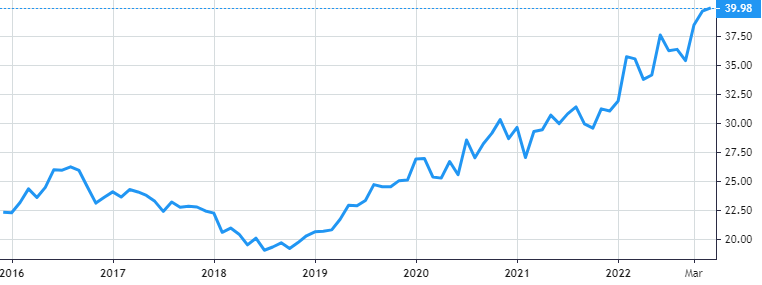About Hydro One
Hydro One Limited (Hydro One) operates as an electricity transmission and distribution utility in Ontario.

Certain of the company’s subsidiaries include Hydro One Inc., which acts as a holding company for its rate-regulated businesses; Hydro One Networks Inc. (HONI), a principal operating subsidiary that carries on the company’s rate-regulated transmission and distribution businesses; Hydro One Remote Communities Inc., which generates and supplies electricity to remote communities in northern Ontario; Hydro One Remote Communities – generates and supplies electricity to remote communities in northern Ontario; Acronym Solutions Inc., which carries on Hydro One’s non-rate-regulated telecommunications business; and Hydro One Holdings Limited – a finance subsidiary with no operational activities.
Hydro One owns and operates substantially all of Ontario’s electricity transmission network and is the largest electricity distributor in Ontario by number of customers. The company’s regulated transmission and distribution operations are owned by subsidiaries of Hydro One Inc. Hydro One delivers electricity safely and reliably to approximately 1.5 million customers across the province of Ontario, and to large industrial customers and municipal utilities. Through its subsidiaries, Hydro One Inc. owns and operates approximately 30,000 circuit kilometres of high-voltage transmission lines and approximately 125,000 circuit kilometres of primary low-voltage distribution lines.
Hydro One’s transmission and distribution businesses are both operated primarily by Hydro One Networks. This allows both businesses to utilize common operating platforms, technology, work processes, equipment and field staff and thereby take advantage of operating efficiencies and synergies. For regulatory purposes, Hydro One Networks has historically filed separate rate applications with the Ontario Energy Board (OEB) for each of its licensed transmission and distribution businesses.
Segments
The company operates through three segments: Transmission Business; Distribution Business; and Other.

Transmission Business segment
This segment consists of owning, operating and maintaining Hydro One’s transmission system, which accounts for approximately 92% of Ontario’s transmission capacity based on revenue approved by the OEB. All of the company’s transmission business is carried out by subsidiaries of Hydro One Inc., including through Hydro One Networks and HOSSM, as well as through the Company’s approximately 66% interest in B2M Limited Partnership and approximately 55% interest in NRLP. Hydro One’s transmission business represented approximately 60% of its total assets as at December 31, 2022, and accounted for approximately 51% of its total revenues, net of purchased power1 in 2022 and approximately 26% of its total revenues in 2022.
The company’s transmission business is a rate-regulated business that earns revenues mainly from transmission rates that are subject to approval by the OEB. Transmission rates are generally determined using a performance-based model, which typically includes a cost-of-service base year. Transmission rates are administered and collected by the IESO and are remitted by the IESO to Hydro One on a monthly basis, which means that Hydro One’s transmission business has no direct exposure to end-customer counterparty risk.
Transmission rates are based on monthly peak electricity demand across Ontario’s transmission network. This gives rise to seasonal variations in Hydro One’s transmission revenues, which are generally higher in the summer and winter due to increased demand, and lower during other periods of reduced demand. Hydro One’s transmission revenues also include revenues associated with exporting energy to markets outside of Ontario.
The company’s transmission system serves substantially all of Ontario and transported approximately 138 terawatt-hours (TWh) of energy throughout the province in 2022. Hydro One’s transmission customers consist of 35 local distribution companies (including Hydro One’s own distribution business) and 85 large industrial customers connected directly to the transmission network, including automotive, manufacturing, chemical and natural resources businesses. Electricity delivered over the company’s transmission network is supplied by 135 generators in Ontario and electricity imported into the province through interties. Interties are transmission interconnections between neighbouring electric systems that allow power to be imported and exported.
Hydro One has approximately 309 in-service transmission stations and approximately 30,000 circuit kilometres of high voltage lines whose major components include cables, conductors and wood or steel support structures. All of these lines are overhead power lines except for approximately 270 circuit kilometres of underground cables located in primarily urban areas.
Hydro One’s transmission network is managed from a central location. This centre monitors and controls the company’s entire transmission network and has the capability to remotely monitor and operate transmission equipment, respond to alarms and contingencies and restore and reroute interrupted power. There is also a backup facility which would be staffed in the event of an evacuation of the centre. In 2022, Hydro One’s new primary control centre became fully operational.
Hydro One uses telecommunications systems for the protection and operation of its transmission and distribution networks.
B2M Limited Partnership is Hydro One’s partnership with the Saugeen Ojibway Nation with respect to the Bruce-to-Milton transmission line. B2M Limited Partnership owns the transmission line assets relating to two circuits between Bruce TS and Milton Switching Station. Hydro One Networks owns the stations where the lines terminate. Hydro One maintains and operates the Bruce-to-Milton line and has an approximately 66% economic interest in the partnership.
Niagara Reinforcement Limited Partnership (NRLP) is Hydro One’s partnership with Six Nations of the Grand River Development Corporation and, through a trust, the Mississaugas of the Credit First Nation. NRLP owns the Niagara Line. Hydro One maintains and operates the Niagara Line, and has an approximately 55% interest in the partnership.
In 2018, Hydro One completed the operational integration of HOSSM, which was acquired in October 2016.
Regulation
The company’s transmission business is required to comply with various mandatory regulations for transmission reliability, including mandatory standards, directories, market rules, and the Transmission System Code (collectively, the Reliability Standards) established by NERC, NPCC, the OEB and the IESO, which are international, regional and Ontario reliability regulatory authorities, respectively, involved in regulating, promoting and otherwise improving the reliability of transmission networks in North America. Hydro One’s compliance with these Reliability Standards is enforced by the OEB, the Independent Electricity System Operator (IESO) and the Canadian Energy Regulator.
In addition to the enforced Reliability Standards, the North American Electric Reliability Corporation (NERC), the Northeast Power Coordinating Council, Inc. (NPCC), the Ontario Energy Board (OEB) and IESO continue to develop and issue new and revised Reliability Standards and other regulations, including Critical Infrastructure Protection Standards and Cybersecurity Regulations with which Hydro One and other utilities, owners and operators of the bulk electricity system in North America must comply. Hydro One expects to continue to perform work, and to incur associated costs, in order to achieve, sustain and demonstrate compliance with all of these Reliability Standards. Hydro One anticipates that these costs will be recovered in rates.
Distribution Business segment
This segment consists of owning, operating and maintaining Hydro One’s distribution system, which Hydro One, through Hydro One Inc., owns primarily through its wholly-owned subsidiary, Hydro One Networks, the largest local distribution company in Ontario. The company’s distribution system is also the largest in Ontario. The company’s distribution business is a rate-regulated business that earns revenues mainly by charging distribution rates that are subject to approval by the OEB. Hydro One’s distribution business also includes the business of its wholly-owned subsidiary, Hydro One Remote Communities, which supplies electricity to customers in remote communities in northern Ontario.
Hydro One’s distribution business represented approximately 38% of its total assets as at December 31, 2022, and accounted for approximately 48% of its total revenues in 2022, net of purchased power,2 and approximately 73% of its total revenues in 2022. Distribution revenues also include minor ancillary service revenues, such as fees related to the joint use of the company’s distribution poles by participants in the telecommunications and cable television industries, as well as miscellaneous charges, such as charges for late payments.
Hydro One delivers electricity through its distribution network to approximately 1.5 million residential and business customers, most of whom are located in rural areas, as well as 44 local distribution companies (including Hydro One’s own distribution business).
Hydro One’s distribution system includes approximately 125,000 circuit kilometres of primary low-voltage distribution lines and approximately 1,000 distribution and regulating stations. Other distribution assets include poles, transformers, service centres and equipment.
Hydro One’s distribution system services a predominantly rural territory. As a result of the lower population density in the company’s service territory, the company’s costs to provide distribution services may be higher than those of distributors who service urban areas. Furthermore, unlike the distribution systems found in urban areas, most of Hydro One’s distribution system was not designed with redundancy, to be interconnected in loops with other distribution lines, with the result that interruptions experienced at any point along a distribution line in Hydro One’s network can cause all customers downstream of the interruption point to lose power. Accordingly, the reliability of Hydro One’s distribution system is lower than that of local distribution companies which service urban territories that typically have redundancy built into their systems.
The company engages in vegetation management activities to maintain the reliability of Hydro One’s distribution system on a preventive basis and to protect public health and safety. This consists of the trimming or removal of trees to lower the risk of contact with distribution lines, thereby reducing the risk of power outages, and preventing potential injury to the public or employees. The company’s monitoring systems assist with determining areas of priority and with system restoration. The company relies on its local line crews for these restoration activities.
Hydro One’s distribution business is involved in the connection of new sources of electricity generation, including renewable energy. Hydro One invests in upgrades and modifications to its distribution system to accommodate these new sources of generation and ensure the continued reliability of its distribution network. As of December 31, 2022, there were approximately 18,000 small, mid-size and large embedded generators connected to Hydro One’s distribution network, including approximately 16,500 generators with capacities of up to 10 kW. As of December 31, 2022, Hydro One also had approximately 137 generators pending connection.
Regulation
Hydro One Remote Communities Inc.’s business is exempt from a number of sections of the Electricity Act, 1998, SO 1998, c 15, Schedule A. The company’s distribution service area is described in its distribution licence issued by the OEB.
Other segment
This segment consists principally of the company’s telecommunications business, which provides telecommunications support for its transmission and distribution businesses. The telecommunications business is carried out by its wholly-owned subsidiary Acronym Solutions Inc. It also offers comprehensive information and communications technology (ICT) services and solutions (including internet and network, security, voice and collaboration, cloud and managed IT) that extend beyond Acronym Solutions Inc.’s fibre optic network, in a competitive commercial market.
HOTI is registered with the Canadian Radio-television and Telecommunications Commission as a non-dominant, facilities-based carrier, providing broadband telecommunications services in Ontario with connections to Montreal, Quebec; Buffalo, New York; and Detroit, Michigan.
Health, Safety and Environmental Management
Hydro One Networks is a designated ‘Sustainable Electricity Company’ by the Canadian Electricity Association.
History
Hydro One Limited was incorporated in 2015 under the Business Corporations Act (Ontario).

 Stock Value
Stock Value

